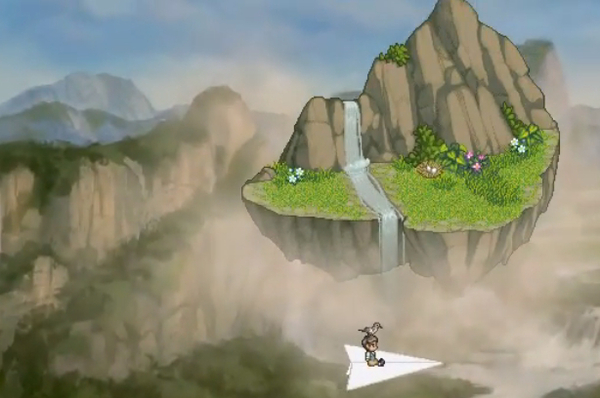
A Bird Story might be short or minimalist, but that doesn’t stop it from laying the sentimentality on thick. Since the game involves the finite relationship between a lonely boy and a bird, some will label you “heartless” if you don’t cry. Indeed, developer Kan Gao’s problem isn’t a lack of appreciation for human sympathy. A Bird Story is simply inconsistent in its attempts to depict human experience and awkward in its transitions from self-unfolding to player-driven action.
At times, A Bird Story is fine surrealism. Gao’s direction is more sophisticated when he focuses on the protagonist’s fear of authority and society. The game’s best scene combines a Marx Brothers routine with a Mario Bros. punchline, as the boy’s teacher and mother incongruously pursue him through a series of doors in a school hall. In another automated scene, the boy falls out of the sky in a failed escape on a giant paper plane; notebook pages, both a symbol of alienation and freedom, follow the boy’s descent like leaves.
Gao shows some cleverness in deemphasizing and sidestepping common technical limitations. Countless videogames restrict player movement with invisible or contrived walls. A Bird Story uses fog to represent such walls in an illustration of the boy’s anxiety in his everyday travels. A Bird Story also blurs the boundaries of buildings and the outdoors and ignores concrete logistics to advance the story faster, reducing the tedium of holding down arrow keys to walk.
At other times, A Bird Story slips out of its surrealism to tug on your heartstrings as much as it can (but without dialogue, unlike Gao’s talkative To the Moon). The game presents the relationship between the boy and the bird as a literal thing but in cartoonish terms. Details such as the bird opening a backpack by itself suggest the game wants to be precious without the obstacle of reality. The ending in particular implies the bird is incredibly cognizant, all for the sake of making you tear up. In contrast, the game doesn’t bother exploring the human characters (besides the boy), who are portrayed as unthinking shadows. Before the finale, every kid on the school playground inexplicably waves to the boy, despite not giving him much positive attention beforehand. Gao only demands understandable (and obvious) feelings from the boy and the bird, as if to peddle the relationship as a single selling point.
A Bird Story has significant aesthetic hiccups for the sake of utterly banal tutorializing. Gao knows he wants to tell a story, but he doesn’t trust his instincts as a game maker or the intuition of players. When A Bird Story needs the player to act, it clutters the screen with arrow keys and other unnecessary hints that Actual Sunlight and Brothers: A Tale of Two Sons avoided in their superior melding of developer-controlled and player-required narrative. A Bird Story is at its worst when it instructs the player to perform activities, such as jumping into a puddle of water, an arbitrary amount of times to advance.
In a nod to the post-credits gimmick of comic book blockbusters, A Bird Story reveals itself as foreplay for Gao’s next game. This shameless preview raises the question of why anyone should take the game’s human-animal bonding as anything more than a tease. Earlier in the game, the boy and the bird are launched into space for a close-up of the moon, a shoehorned reference to Gao’s To the Moon. Despite its well-meaning qualities, A Bird Story doesn’t have the maturity or confidence to inspire much more than crying and buying.
A Bird Story was developed and published by Freebird Games. Our review is based on the PC version. It is also available for Mac and Linux.
Jed Pressgrove is a videogame critic from Mississippi. He writes at Game Bias.
